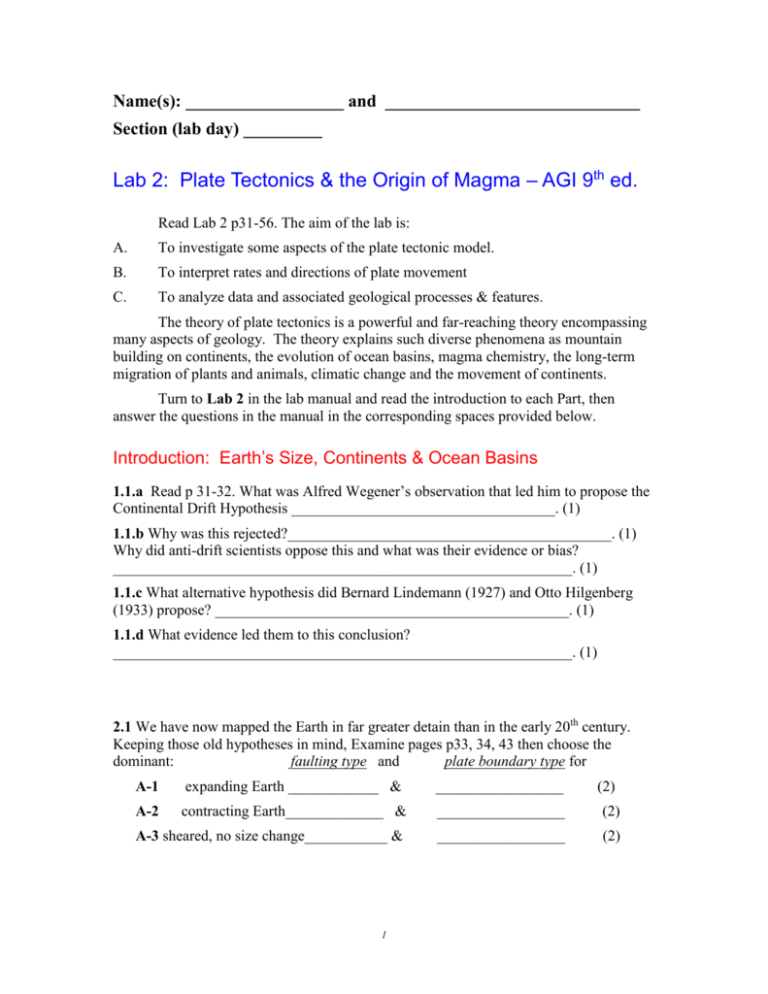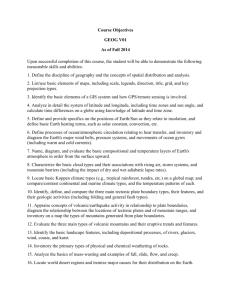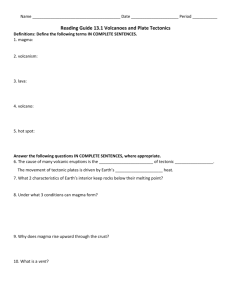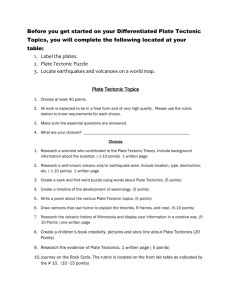Lab 2
advertisement

Name(s): __________________ and _____________________________ Section (lab day) _________ Lab 2: Plate Tectonics & the Origin of Magma – AGI 9th ed. Read Lab 2 p31-56. The aim of the lab is: A. To investigate some aspects of the plate tectonic model. B. To interpret rates and directions of plate movement C. To analyze data and associated geological processes & features. The theory of plate tectonics is a powerful and far-reaching theory encompassing many aspects of geology. The theory explains such diverse phenomena as mountain building on continents, the evolution of ocean basins, magma chemistry, the long-term migration of plants and animals, climatic change and the movement of continents. Turn to Lab 2 in the lab manual and read the introduction to each Part, then answer the questions in the manual in the corresponding spaces provided below. Introduction: Earth’s Size, Continents & Ocean Basins 1.1.a Read p 31-32. What was Alfred Wegener’s observation that led him to propose the Continental Drift Hypothesis ___________________________________. (1) 1.1.b Why was this rejected?___________________________________________. (1) Why did anti-drift scientists oppose this and what was their evidence or bias? _____________________________________________________________. (1) 1.1.c What alternative hypothesis did Bernard Lindemann (1927) and Otto Hilgenberg (1933) propose? _______________________________________________. (1) 1.1.d What evidence led them to this conclusion? _____________________________________________________________. (1) 2.1 We have now mapped the Earth in far greater detain than in the early 20th century. Keeping those old hypotheses in mind, Examine pages p33, 34, 43 then choose the dominant: faulting type and plate boundary type for A-1 expanding Earth ____________ & _________________ A-2 contracting Earth_____________ & _________________ (2) A-3 sheared, no size change___________ & _________________ (2) 1 (2) 2.1.B Complete the Table noting the features & directions in Figs 2.1, 2.2 p 33, 34. (12) Boundary Type Major Stress Relative Plate Motion Fault Type & Other geological features or processes Divergent Convergent Transform 2.1.C On Fig 2.3 p.36, Use a string and ruler to estimate total length and percentages of each type boundary. Hint: you can measure several ridge segments at once as long as you measure along the ridge direction. You can measure several transform segments at once as long as you measure across the ridge direction. Note that the ridge spreading segments are in bold red and the transform offsets are grey. Measure trenches (subduction zones by following the curve with your string, as long as they are not segmented. 1) Transform: Length:_____________km , ___________ % (2) 2) Divergent: Length:_____________km , ___________ % (2) 3) Convergent: Length:____________km , ___________ % (2) 2.1.D The evidence from the figures, including your completed 2.4 and Q’s 1-3 suggests that Earth is: ( Circle your answer ) Expanding Contracting Staying the same (1) Explain: ______________________________________________________________ _____________________________________________________________________ _____________________________________________________________________(2) 2.1.E Do you think that Plate tectonic motions is caused by changes in earth’s size and justify your answer. (2) ________________________________________________________________________ ________________________________________________________________________ ________________________________________________________________________ 2 Part 2-2: Mechanisms of Plate Motion (read 34-35 then answer Q’s) Observe a lava lamp for a few minutes. A-1 Sketch and label and describe in words, the motions of oily and waxy fluids in a lava lamp. (3) A-2 Why does “waxy-lava” rise and where does the heat come from? ________________ ________________________________________________________________________ ________________________________________________________________________(2) A-3 Why does “waxy-lava” sink and where does the heat go to? ____________________ ________________________________________________________________________ ________________________________________________________________________(2) A-4 See p5, fig 1.4. When heat, mass and momentum all move together in a confined space, the cyclic process of doing work while rising and sinking is called: _____________(2) Part B: Examine Fig 2.4 and read p. 34-35. How is Earth’s mantle in terms of heating, cooling and the process of heat and mass transfer: B-1 Like a lava lamp? ______________________________________________________ ________________________________________________________________________ ________________________________________________________________________ ________________________________________________________________________(3) B-2 Different from a lava lamp in terms of the physical processes involved? What is the state of the mantle? How fast does it move? How long does one cycle take? ___________ ________________________________________________________________________ ________________________________________________________________________ ________________________________________________________________________ ________________________________________________________________________(3) 3 Part C: Compare Plate boundaries in Fig 2.3 to the seismic tomography’s Red and Blue regions in Fig 2.4. Red corresponds to seismic P-wave slowness and Blue to fastness from earthquake arrival times. Because the interior of the Earth is not uniform in density and temperature, sometimes the waves from distant large earthquakes arrive either too soon or too late compared to an average Earth. Don Anderson and his students at Cal Tech spent more than a decade measuring and mapping this “seismic tomography” of the Earth’s interior to produce this slice at 300 km depth in the Asthenosphere (and medical doctors were so intrigued that they then applied this kind of imaging to the human body inventing ultrasound, CAT scans and MRI imaging.) Recall what you learned from the different kinds of crust & isostasy in Lab 1. Relative to the lithospheric plate boundaries, where do: C-1 the slower, warmer, less dense mantle rocks mostly occur? _____________________ ________________________________________________________________________ ________________________________________________________________________(2) C-2 faster, cooler, more dense mantle rocks mainly occur? ________________________ ________________________________________________________________________ ________________________________________________________________________(2) D From Fig’s 1, 2.1, 2.3 & 2.4 and your sketch of the lava lamp, Provide a simple, labeled sketch showing a wedge shaped section of a global cross section through the mantle like Fig. 2.1 but deeper. Label depth in km & the different layers from the outer core to the crust including the upper mantle, its driving mechanism with arrows to show convective motions of solid mantle rocks & tectonic lithospheric plates. (10) 4 Activity 2.3: Using Earthquakes to Identify Plate Boundaries 2.3-A Use the map of earthquakes in the eastern Pacific and South America region to locate plate boundaries. Refer to figure 2-3 for help in finding the boundaries and plates. On your map, use a red for ridges, black for transform faults and blue for subduction zones, showing where these plate boundaries occur on the Earth’s surface. Don’t forget the transform faults, you should be able to find at least 10! After doing this, label the following plate boundaries: the EPR-East Pacific Rise, GR-Galapagos Rise, CR-Chile Rise, MAT-Middle America Trench, PCT-Peru Chile Trench. Now label the plates represented on this map: Antarctic, Caribbean, Cocos, Nazca, Pacific & South American and show their relative directions of motion with small arrows. Do this work on the following map provided. It is labeled p. 47. (17) 2.3-B Cross section of Nazca-South America subduction zone (Peru Chile Trench through Andes). Complete this on the table provided (p.48) and answer the 5 questions below. (20) Activity 2.4: Analysis of Atlantic Seafloor Spreading A.1 On the attached map of the Mid-Atlantic Ridge, label the Ridge segments in Red (4) A.2 the Transform faults (at least 2 of them) in Blue (2). B. Calculate the half-spreading rate for segment B-A _____________ km/Ma and for segment A-C ____________ km/Ma. (4) C.1 How far apart are B and C _______ km? (1) C.2 Calculate the average full spreading rate in km/Ma for B-C and show your work. (2) C.3 Convert the answer you just got to cm/yr. Show your work. Keep in mind that there are 106 years in a Ma (mega annum) and 105 cm in a km. What is this value in mm/yr? (3) D. Using the average spreading rate in C.2 above, estimate how long it has been since Africa and North America were together as Pangea? Show your work. (2) E. Estimate the increased distance in meters between D-E in the last 400 years? (2) 5 Insert pages: 47, 48 & 49 here 6 7 8 Activity 2.5: Plate Motions Along the San Andreas Fault (California) A.1.a Using the map on p 51, Calculate the average rate of strike slip faulting across the fault for the past 25 Ma in cm/yr by measuring the modern distance in km between the centres of the 2 Miocene sedimentary basins. Don’t forget to convert your units! (3) A.1.b Although both sides of the fault are moving, pretend the Green Cretaceous batholith by Berkeley has been fixed in its current location. Calculate and describe the position of the western coastal batholith about 100 Ma when these were originally intruded and show this with the letters CRB on the map provided. Were these intrusions originally so close to each other? Describe where these Arc rocks came from? (4) A.2. Using the same map of the San Andreas (p.51), Assume that all of the displacement of the 10 Ma Miocene sediments occurred in 5 m jumps like the great 1906 San Francisco Earthquake, how many such earthquakes have there been? Having calculated the total count of large earthquakes here for this 10 Ma time interval, what is the average number of years between these big earthquakes? Show your work. (4) B.1 Using the GPS station motions on the map on p 52, on average, how much faster is the Pacific plate (west side of San Andreas here) moving NW than North America in the same region. Give your answer in mm/yr. (3) B.2 Label the San Andreas Fault here in Southern California and show the relative motion arrows across the fault, this time splitting the NW and SE motions evenly and let the length and vector directions of your arrows reflect this. (4) 9 Insert p.51 & 52. Here 10 11 Activity 2.6: Hawaii Hot Spot & Pacific Plate Motions Dr. J. Tuzo Wilson, a geophysicist at the University of Toronto, developed the Hot Spot hypothesis to explain the progression in ages along the Hawaii-Emperor seamount chain. The idea is that a hot, long lived place in the Mantle continues to upwell and partially melt, as the lithosphere of the Pacific Plate slid over this. When this hot spot was considered together with 20 or more other major long lived hot spot volcanoes around the world (Iceland, Yellowstone, Kilimanjaro, Reunion, Azores etc.) it permitted a “hot spot reference frame” to form a reference frame, against which to measure global plate motions. This was extensively used by other researchers including David C. Engebretson, Alan Cox and R. D. Gordon (1985) to track plate motions and make a global plate model back through the Cretaceous. Other approaches for calibrating plate tectonic motions involve the measurement of magnetic stripes on the seafloor due to past magnetic reversals and creating “Global Plate Circuit Models” like those pioneered by Joanne Stock and Peter Molnar (1983). A. Refer to Figure 2.5A & B on p.38 provided. Measure the distances the Pacific Plate moved using the scale in the lower left corner of figure 2.5 B & divide this by the appropriate time interval to calculate rates of motion. For converting units recall that there are 10,000 cm/km and one million years in a million years! For directions, draw an arrow from the youngest point of each pair to the oldest point and give its cardinal direction relative to the North arrow on the figure provided. 1. From 4.7 to 1.6 million years ago rate of movement = ________________ cm/yr (1) Show this on your map with an arrow for direction the Pacific Plate motion (1). Describe this direction in terms of compass directions = _________________ (1) 2. From 1.6 million years ago to the present, the rate was = _____________ cm/yr (1) Show this on your map with an arrow for direction the Pacific Plate motion (1). direction = _________________ (1) 3. Compared to the older Pliocene rate the current rates is: slower / faster Compared to the older Pliocene direction, the modern Pacific plate motion is: _________________________________________________________________ (1) (1) 4. On Fig 2.5 A provided, Label HHC-Hawaiian Hotspot Chain and the Early Cenozoic ESC-Emperor chain. (2) Describe how these 2 chains were related. (They were both able to form on the Pacific Plate, yet apparently head different directions.): ___________________________________________________________________ (2) ________________________________________________________________________ 5. What was the direction of the Pacific plate motion during Early Cenozoic when the Emperor Chain was formed? How and when did this direction change? Label the new SZ-subduction zone that formed at this time on the map. (3) __________________________________________________________________ 12 Insert p38 here 13 Activity 2.7: Plate Tectonics of Cascadia: Southern BC, Washington & Oregon A. Study p.39 & Fig 2.6 provided, for the tectonic environment of the Cascadia Subduction Zone and the plate boundaries between the western edge of the North America Plate with the Juan de Fuca Plate and Pacific Plate further north. Observe the location and trend of the Yellowstone Hotspot track after Mark Anders (1989) and see how it has apparently “blowtorched” its way up across this edge of the North America Plate. As with the Hawaiian exercise in problem, use the map scale for distances and recall that the direction of plate motion is an arrow pointing from younger to older positions as North America has overridden the Yellowstone hotspot. Northwest of the Juan de Fuca Ridge (in red on the map), the Queen Charlotte Transform Fault makes the boundary between North America and the Pacific Plate. Label: NAP – North America Plate, JFP - Juan de Fuca Plate, PP - Pacific Plate, JFR – Juan de Fuca Ridge, CSZ Cascadia Subduction Zone, QCF – Queen Charlotte Fault and the relative motion vectors for each plate direction. (10) 1. Describe this direction in words or degrees relative to N = 0° ______________ Draw this motion for North America with a Blue Arrow on your map. (1) (1) 2. What was the rate in cm/yr between 13.8 Ma and 0.5 Ma judging from the centres of the deformation zones? ________________________________________________ (1) B. Note the coloured bands of seafloor from magnetic stripes of different ages and directions on figure 2.6. 1. Calculate the spreading rates for the Juan de Fuca-Pacific Spreading Ridge: a. For line B-C during the past 8 million years?_________________________cm/yr (1) b. Along line A-B during the past 8 million years?_______________________cm/yr (1) 2. What has happened to the seafloor older than 8 Ma between CD and why is it not shown on the surface of this geological map? ______________________________ __________________________________________________________________ (2) 3. What tectonic boundary is represented by the Red Line at C? _______________ (1) 4. What kind of melting process is responsible for the Cascades volcanoes and why are they found in this location , at this distance behind the North America - Juan de Fuca boundary? (2) __________________________________________________________________ 14 Insert p 39, 41, 56 here 15 16 17 Activity 2.7: The Origin of Magma A. Examine Fig.2.7 on p.41 provided. This is a phase diagram for peridotite in the upper mantle. The bold line is the dry peridotite solidus and the dry basalt liquidus. The dashed line is the dry peridotite liquidus. The Dotted Line from Azuza et al (2009) shows the water saturated Peridotite Solidus = Basalt Liquidus. Water becomes a better solvent at higher pressure. The fainter solid lines to the left describes the geothermal gradients beneath continents and oceans, which you already know are different from fig.2.4. The 2 vertical scales show the equivalence and relationship between depth and pressure in the mantle. Essentially 100 km equasls 30kbar or there is a pressure gradient of about 3.3 km/kbar in the Earth. Use this graph to estimate the following: 1. a. Rocks at 80 km depth beneath a Continent would be at: _________ °C (1) 2. Rocks at 80 km depth beneath an Ocean Basin would be at: ________ °C (1) 3. The Peridotite at X would be: (Choose and circle one answer): solid / solid + liquid / liquid Explain why the peridotite at X will be in this state? (1) (1) _______________________________________________________________________ 4. What would happen to the peridotite X at a constant depth of 80 km if it were heated to 1750°C ? ____________________________________________________________ (1) Why? _______________________________________________________________ (1) 5. What would happen to the peridotite X at a constant pressure (isobaric) of 25,000 atm or depth of 80 km if it were heated to 2250°C ? _____________________________ (1) Why? _______________________________________________________________ (1) B. Refer to Figure 2.7 p 41. The Peridotite at X is currently at 25 kbar. 1. If the peridotite at X were uplifted At constant heat content (adiabatic conditions): by tectonic rifting or rapid erosion, at what depth level and pressure would it begin to melt if it kept its 1200°C temperature? i.e. when does it hit the dry peridotite solidus? _________________Depth (km) ________________Pressure (atm) (2) 18 2. The name for this kind of partial melting caused by uplift at constant heat is called ____________ decompression (1) Refer to figures 2.1, 2.5 and 2.6. 3.a. What tectonic process of mantle motion leads to this kind of uplift ____________ (1) 3.b. This type of melting occurs under within-plate hotspots like Hawaii, Yellowstone or Iceland, however, it occurs more frequently beneath which tectonic setting ________ (1) C. While most of the upper mantle is too cold to melt, nonetheless basaltic magmas arise from depths like point X for 2 dominant reasons or processes. Simplify in your own words, your conclusions from problems A and B. For the peridotie at X to begin to melt, either…. 1. What would have to happen to the temperature (or heat content)? ______________ (1) 2. What would have to happen to the pressure? ________________ ______________ (1) D. Refer to Figure 2.8 and examine the demonstration with the hotplate and sugar cubes. 1. Which cube melted first? (Circle one) The wet one / The dry one (1) 2. The flux was ______________________________________________________ (1) 3.a. Refer to my version of fig 2.7 and note the position of the Wet Peridotite Liquidus. What would happen to the peridotite at X if the peridotite was suddenly wetted? (1) _______________________________________________________________________ 3.b Is this (hotter than) above or (colder than) below the Oceanic geotherm? ______ (1) 4.a At which plate tectonic environment could cold water most easily enter the mantle? ___________________________________________________________________ (1) 4.b What was the physical material that held this water before it was carried down into the mantle ____________________________________________________________ (1) E. Refer to upper Figures on p.56 provided. 1. What type of plate boundary is pictured? __________________________________ (1) 2. Which of the melting processes produced the magma?_______________________ (1) 3. Describe the sequence of tectonic and mantle processes that led magmas to form here? ____________________________________________________________________ (3) _____________________________________________________________________ 19 F. Refer to lower Figure on p.56 provided. 1. What type of plate boundary is pictured? ______________________________ (1) 2. Which of the 3 melting processes produced the magma?__________________ (1) 3. Describe the sequence of tectonic and mantle processes that led magmas to form here? ____________________________________________________________________ (3) _____________________________________________________________________ 20







